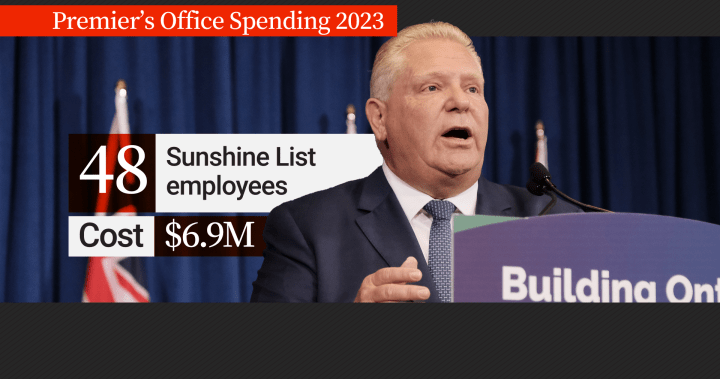The cost of staffing the premier’s office under Doug Ford has more than doubled since 2018, according to public salary disclosure data, far outpacing his predecessor Kathleen Wynne. The total number of staff in the premier’s office under Ford, along with the number of people earning six figures, has grown significantly since 2019. Critics argue that Ford’s increased office spending is in direct contradiction to his promises of fiscal responsibility when he took office in 2018. The surge in costs has led to concerns about the effectiveness and efficiency of the premier’s office, with some questioning the value taxpayers are getting for the increased spending.
In 2019, the Progressive Conservative Party’s first full year in office, 20 employees in the premier’s office made the Sunshine List, costing taxpayers $2.9 million in total compensation. By 2023, the number of premier’s office employees on the Sunshine List more than doubled to 48, with a combined compensation of $6.9 million. Jay Goldberg of the Canadian Taxpayers Federation described the increase as “unacceptable,” questioning whether the premier’s office has become two or three times more effective than in previous years. The significant rise in staffing costs has raised concerns about the impact on overall government spending and the need for fiscal restraint.
Critics, including Liberal MPP John Fraser, have accused Doug Ford of riding his own “gravy train” in the premier’s office, despite his earlier promises to cut government waste and prioritize taxpayer dollars. The surge in costs at the premier’s office under Ford has also raised questions about the government’s overall financial management. In the same budget where the increased office spending was revealed, there was also criticism of the government’s $9.8 billion deficit in 2023, which is larger than Wynne’s $7.8 billion deficit in her final budget in 2018. The government’s increasing debt levels, coupled with rising spending, have prompted calls for a thorough review of government spending at all levels.
The government’s $9.8 billion deficit in 2023 is part of a larger pattern of increased spending and debt accumulation under Doug Ford’s leadership. Since taking office, Ford has added $86.7 billion to the provincial debt, compared to the $61.4 billion added by the Liberals over a similar five-year period. The ballooning deficit and debt levels, combined with the significant increase in staffing costs at the premier’s office, have underscored the need for greater scrutiny and accountability in government spending. Critics argue that runaway spending is unsustainable and that steps need to be taken to rein in costs and prioritize prudent fiscal management.
The lack of transparency from the premier’s office on what is driving the surge in costs and whether any steps have been taken to reduce the size of the office has further fueled concerns about accountability and responsible stewardship of taxpayer dollars. Calls for a top-to-bottom review of government spending and leadership from the top have been made to address the growing financial challenges facing the province. The need for leadership to prioritize fiscal responsibility and efficiency in government operations has become increasingly urgent in light of the escalating deficit, debt, and spending trends. Ultimately, the focus on reining in costs and ensuring effective use of taxpayer dollars is essential for the long-term financial health and sustainability of the province.


